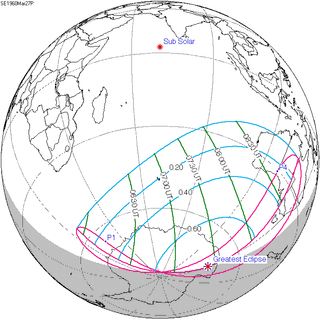Solar eclipse of March 27, 1960
Appearance
| Solar eclipse of March 27, 1960 | |
|---|---|
| Type of eclipse | |
| Nature | Partial |
| Gamma | −1.1537 |
| Magnitude | 0.7058 |
| Maximum eclipse | |
| Coordinates | 72°06′S 151°54′E / 72.1°S 151.9°E |
| Times (UTC) | |
| Greatest eclipse | 7:25:07 |
| References | |
| Saros | 148 (18 of 75) |
| Catalog # (SE5000) | 9420 |
A partial solar eclipse occurred on Sunday, March 27, 1960. A solar eclipse occurs when the Moon passes between Earth and the Sun, thereby totally or partly obscuring the image of the Sun for a viewer on Earth. A partial solar eclipse occurs in the polar regions of the Earth when the center of the Moon's shadow misses the Earth. This eclipse was observable from parts of the Antarctic Ocean and Indian Ocean.
Related eclipses
Solar eclipses of 1957–1960
This eclipse is a member of a semester series. An eclipse in a semester series of solar eclipses repeats approximately every 177 days and 4 hours (a semester) at alternating nodes of the Moon's orbit.[1]
| Solar eclipse series sets from 1957 to 1960 | ||||||
|---|---|---|---|---|---|---|
| Descending node | Ascending node | |||||
| Saros | Map | Gamma | Saros | Map | Gamma | |
| 118 |  1957 April 30 Annular (non-central) |
0.99918 | 123 |  1957 October 23 Total (non-central) |
-1.00218 | |
| 128 |  1958 April 19 Annular |
0.27499 | 133 |  1958 October 12 Total |
-0.29506 | |
| 138 |  1959 April 08 Annular |
-0.45463 | 143 |  1959 October 02 Total |
0.42075 | |
| 148 |  1960 March 27 Partial |
-1.15375 | 153 |  1960 September 20 Partial |
1.20565 | |
References
- ^ van Gent, R.H. "Solar- and Lunar-Eclipse Predictions from Antiquity to the Present". A Catalogue of Eclipse Cycles. Utrecht University. Retrieved 6 October 2018.

